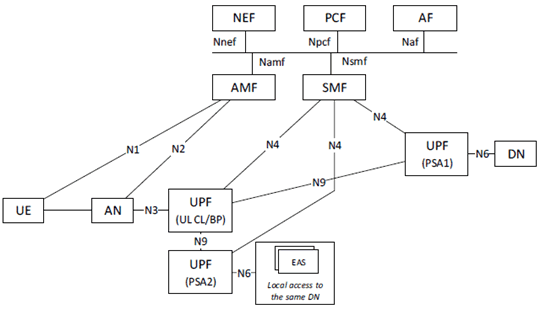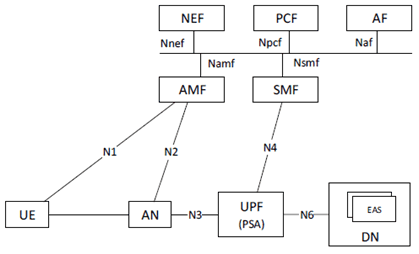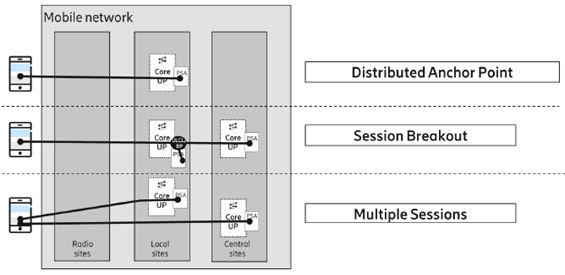Content for TR 23.748 Word version: 17.0.0
4 Architectural Assumptions and Principles
4.1 Architecture Assumptions
4.2 Connectivity Models for Edge Computing
4.3 General Requirements and Assumptions
5 Key Issues
5.1 Key Issue #1: Discovery of Edge Application Server
5.2 Key Issue #2: Edge relocation
5.3 Key Issue #3: Network Information Provisioning to Local Applications with low latency
5.4 Key Issue #4: Consecutive traffic steering in different N6-LAN
5.5 Key Issue #5: Activating the traffic routing towards Local Data Network per AF request
...
...
4 Architectural Assumptions and Principles p. 14
4.1 Architecture Assumptions p. 14
The following architecture figures show 5GS and Edge Application Servers hosted in Edge Hosting Environment.


4.2 Connectivity Models for Edge Computing p. 15
5GC supports at least following three connectivity models to enable Edge Computing:
- Distributed Anchor Point: the PDU Session anchor is moved far out in the network, to the local sites. It is the same for all the user PDU session traffic. Re-anchoring (SSC#2 and SSC#3) is used to optimize traffic routing for all applications when moving long distances.
- Session Breakout: The PDU session has a PDU Session anchor in a central site and a PDU Session anchor in the local site. Only one of them provides the IP anchor point. The Edge Computing application traffic is selectively diverted to the local PDU Session anchor using UL Classifier or multihoming BP technology. Re-anchoring of the local PDU Session anchor is used to optimize traffic routing for locally diverted traffic as the user moves.
- Multiple PDU sessions: Edge Computing applications use a specific PDU session with the PDU Session anchor in the local site. The rest of applications use a PDU Session with a central PDU Session anchor. The mapping between applications and PDU sessions is steered by the URSP rules. Re-anchoring (SSC#2 and SSC#3) is used to optimize traffic routing for Edge Computing applications as the user moves.

4.3 General Requirements and Assumptions p. 16
The architecture for support of Edge Computing in 5GC shall be based on the following architecture principles:
- The architecture shall support scenarios where UEs are unaware of Edge Computing.
- The architecture shall support scenarios where UEs are aware of Edge Computing.
- The architecture shall support scenarios where applications are unaware of Edge Computing.
- The architecture shall support scenarios where applications are aware of Edge Computing.
- It shall be possible for Application Clients in the UE to use Edge Computing without any specific edge computing logic in the Application Client.
- The 5GC shall only support the edge computing hosting Environment beyond the PSA/UPF.
- The edge computing hosting environment may be under the control of the operator or under the control of third parties.
- It shall be possible for an edge computing hosting environment to connect to several PLMNs.
- It shall be possible for an edge computing hosting environment to have no connectivity with the central data network.
- It shall be possible for an edge computing hosting environment to have connectivity with the central data network.
- The architecture should support one PLMN that is connected to several providers of edge computing host environments.
- A PLMN operator shall continue to have the possibility to provide edge computing service differentiation (e.g. by enabling/disabling the Edge Computing features).
- The architecture used for 5GC Edge Computing shall continue to leverage on already developed features in 3GPP Rel-15 and Rel-16.
- The architecture should leverage on widely used IP mechanisms, e.g. DNS, when applicable. Any solution based on DNS needs to consider that DNS traffic may be encrypted between the UE and the DNS Resolver in the operator or 3rd party network.
- Solutions shall build on the 5G System architectural principles as in TS 23.501, including flexibility and modularity for newly introduced functionalities.
- 5G System shall enable edge computing support for all connectivity models in the 5G system including the ones listed in clause 4.2.
5 Key Issues p. 17
5.1 Key Issue #1: Discovery of Edge Application Server p. 17
5.1.1 General description p. 17
In Edge Computing deployment, one application service might be served by multiple Edge Application Servers typically deployed in different sites. These multiple Edge Application Server instances that host same content or service may use a single IP address (anycast address) or different IP addresses. Before an application/UE starts to connect to the service, it is very important for the application/UE to discover the IP address of one suitable Edge Application Server (e.g. the closest one), so that the traffic can be locally routed to the Edge Application Server via UL CL/BP mechanisms, and service latency, traffic routing path and user service experience can be optimized. Also once a discovered Edge Application Server becomes non-optimized (e.g. after the UE moves far away), a new Edge Application Server may be used to replace the old one to serve the application/UE.
The reselection of an Edge Application Server can be triggered by events either in the 5GS or in the application layer. For example, in the first case it can be triggered by a User Plane change initiated by the network such as a mobility event (e.g. handover), or a failure event which ultimately is a 5GS criterion. In the second case it can be initiated due to an Edge Application Server may become congested or unavailable. This requirement depends on whether the application can tolerate a change of Application server instance.
The following aspects shall be studied to support the efficient discovery of Edge Application Sever:
- How can a UE discover a suitable Edge Application Server to serve the application/UE?
- Consider scenarios (if any) for which the UE needs to be aware that there is an application server in the Edge Hosting Environment and scenarios (if any) for which the UE does not need to be aware that there is an application server in the Edge Hosting Environment.
- What information (if any) can be used to assist such a discovery mechanism?
- What (if any) additional information may need to be discovered about the EAS through such a discovery mechanism?
- Whether and if yes how to support UE rediscovery of Edge Application Server when the previous Edge Application Server becomes non-optimal or unavailable to the UE?
-
Whether the need to ensure the discovery of Edge Application Server and PSA UPF selection and reselection are jointly carried out? If so, how?
- The MNO is in control of the edge and provides the edge computing infrastructure, the connectivity and the application platform, and manages the Edge Application Servers.
- The MNO hosts its own or a 3rd party application platform on its edge computing infrastructure. MNO provides the routing and IP network stitching between the connectivity and the platform which exposes APIs for application management.
- The MNO provides distributed connectivity to a DN, and cloud providers host the application servers on their application platform on the edge.
- How can DNS resolution take into account different PSAs for different applications?
- Does the 5GC needs to assist the DNS resolution?
5.2 Key Issue #2: Edge relocation p. 18
5.2.1 Description p. 18
With edge computing being deployed for 5G systems, UE mobility and application server relocation need to be considered when designing solutions for optimal deployment of edge solutions. For example, as the UE moves across the 5G system, the UE location may change and require the network and the edge to deal with the change of UE location. 3GPP Rel-16 specifications already address some of these aspects and the key issue is to study potential improvements.
Clause 6.5.2 of TS 22.261 contains requirements that are related to this key issue. SA WG1 defined the term Service Hosting Environment that has been translated and broadened in SA WG2 work in the present TR to Edge Hosting Environment as the environment providing support required for Edge Application Server's execution. The requirements from SA WG1 are thus being interpreted as applying to the Edge Hosting Environment.
The following scenarios of UE mobility and application server relocation will be investigated:
- Change of the serving Edge Application Server with no change of DNAI. This includes:
- Change of the Edge Application Server e.g. due to the serving Edge Application Server becoming congested or being in outage condition. This assumes EAS IP address change.
- Change of the DNAI depending on the location of the UE to better serve the UE. This may imply EAS IP address change but in some cases the old EAS may be kept as long as the UE transaction is not over.
- Potential improvements of the coordination of change of the Edge Application Server and (local) PSA to support seamless change, e.g. preventing or reducing packet loss.
- What triggers should be considered, and which functional entities trigger the changes to support service continuity for the scenarios described above.
- Whether existing SA WG2 mechanisms (e.g. ULCL/BP insertion/relocation, SSC mode 2/3, AF influence on traffic routing, and LADN) suffice or whether there are gaps to be addressed that could introduce improvements in Quality of Experience compared to existing solutions.
- How to handle changes of the (local) PSA when applications do not support the change of client address.
- How to handle change of the serving EAS (without UE mobility) to support seamless change, e.g. preventing or reducing packet loss.
- How to handle coordination of change of the Edge Application Server and PSA to support seamless change, e.g. preventing packet loss. This should consider the already specified mechanisms in clause 4.3.6.3 of TS 23.502 "Notification of User Plane Management Events".
-
Evaluate and determine whether and how seamless change of Edge Application Server can be enabled considering:
- Different Edge hosting models described in the key issue #1.
- Stateful and Stateless applications.
5.3 Key Issue #3: Network Information Provisioning to Local Applications with low latency p. 19
5.3.1 Description p. 19
With edge computing deployment, it is expected that a set of edge computing functions or edge application servers running on edge hosting environment will need to interact with the 5GS to access to 5GS functionality and information, and/or to provide information to 5GS for the provisioning of connectivity services supporting edge computing. The interaction for exposure of network information between the 5GS and the edge computing functions need to be studied.
As part of the study, latency of network exposure needs to be considered. Current network exposure mechanism in 5GS is designed based on NEF and other control plane NFs, e.g. AMF, SMF, PCF etc. For applications deployed in edge hosing environments, the Edge Application Servers or Application Functions may be locally deployed, but in current Rel-16, some Control Plane NFs involved in network exposure, e.g. NEF and PCF, are likely deployed centrally to avoid frequently relocation. This may result in a less than efficient network exposure path in terms of latency.
For some network information to be exposed, the long exposure latency is tolerable. However, some real time network information, e.g. network congestion condition or real-time user path latency, can change very frequently. If this information needs to be delivered to Application servers or Application Functions timely, undesirable latency may make the information obsolete cause applications to adjust their behaviour (e.g. adjust the resolution of video stream, or switch levels of driving automation) based on out-of-date network information.
Examples of existing QoS information that may need to be exchanged quickly between network and Application Functions (e.g. Edge Application Servers) include:
- The AF may subscribe to receive QoS congestion condition notifications.
- The AF may request 5GC to monitor QoS status (e.g. over-the-air and/or end-to-end data path) and receive QoS measurement reports.
- Which information that have already existed in Rel-16 needs to be exposed with low latency to the edge computing functions by the 5GS?
- How does the 5GC determine whether a network information need to be exposed with low latency?
- How to expose the network information to the application functions deployed in the edge with low latency?
- Whether and how to maintain the exposure when the UE moves out of the coverage of NF(s) supporting the exposure?
5.4 Key Issue #4: Consecutive traffic steering in different N6-LAN p. 20
5.4.1 Description p. 20
For some of edge computing use case scenarios, although Application Servers are deployed in the local N6-LAN, centralized deployed Application Server(s) may still be required for other processing. In such edge computing scenarios:
- UL traffic related to an application may be first steered over local N6-LAN to Application Server(s) for local-processing, and then further steered to the central Application Server(s).
- DL traffic related to an application may be first routed via Application Server(s) in the central N6-LAN, then steered to Application Server(s) in local N6-LAN for local-processing, and finally provided to the UE.
-
The following aspects will be studied in this key issue:
- How to steer application traffic for processing at different locations (e.g. at the local Application first and then at the central application server(s)/or UE, or at the central application server first and then at the local application server), e.g. via DN/internet, back via the 5GC or using multiple PDU sessions.
-
Depending on the architecture for the item 1) above:
- Whether and how is the 5GC made aware that (UL/DL) application traffic needs to be processed via the local N6-LAN and the central N6-LAN;
- How to provide the 5GC with information about service functions in N6-LAN (both local and central) that application traffic needs to travel through, e.g. service function order and location;
- How can local 5GC NF(s) distinguish the UL traffic and the DL traffic that need to be processed via either the local N6-LAN or the central N6-LAN, or both.
- How to guarantee proper enforcement of the Policy Rules, QoS handling, Packet marking, packet buffering and rest of UPF functions.
- How to guarantee proper usage reporting for usage monitoring and charging.
5.5 Key Issue #5: Activating the traffic routing towards Local Data Network per AF request p. 21
5.5.1 Description p. 21
In order to activate the traffic routing towards Local (access to) Data Network, the SMF should be configured with the requested DNAI. For ETSUN case, either SMF or I-SMF should be configured with the requested DNAI.
For some of edge computing use case scenarios, the SMF or I-SMF of the PDU Session may not be configured with the requested DNAI. In this case the mechanism to activate the traffic routing towards the Local Data Network should be studied.
The key issue aims at studying the following:
- Whether Rel-16 ETSUN solution is sufficient to support the use case above and if there is a gap.
- If Rel-16 ETSUN solution is not sufficient (there is a gap), study potential solutions on how to activate the traffic routing towards Local Data Network when the SMF does not support the requested DNAI, or for ETSUN case both SMF and I-SMF do not support the requested DNAI in the AF request.